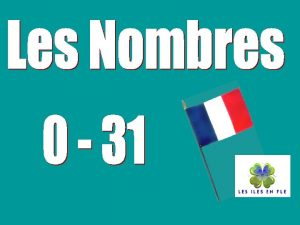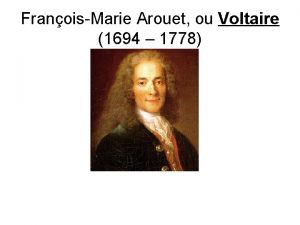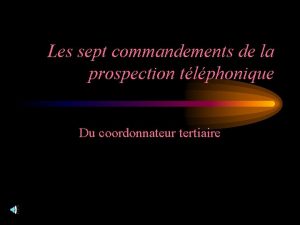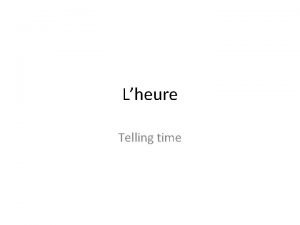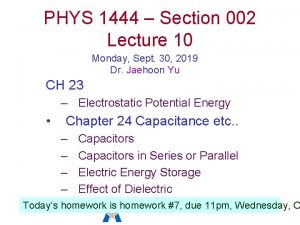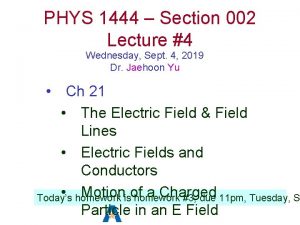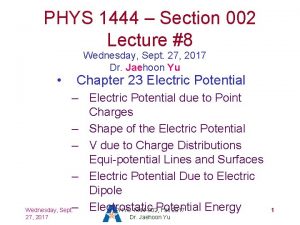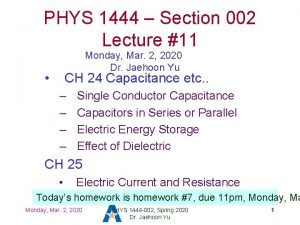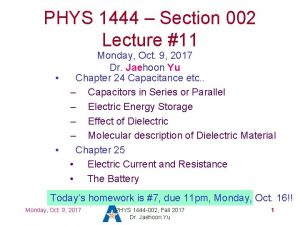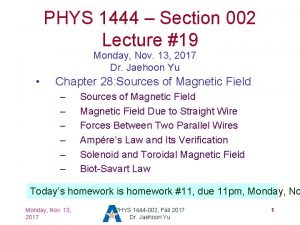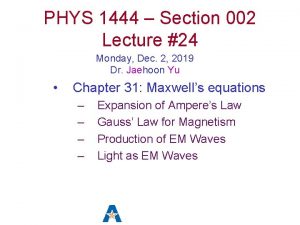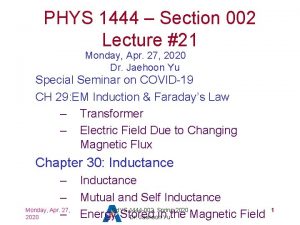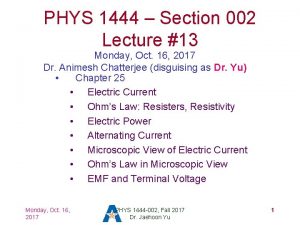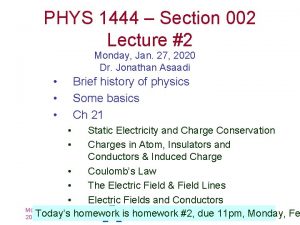PHYS 1444 Section 002 Lecture 7 Monday Sept













- Slides: 13

PHYS 1444 – Section 002 Lecture #7 Monday, Sept. 16, 2019 Dr. Jaehoon Yu CH 22 – Gauss’ Law with Multiple Charges CH 23 – Electric Potential Energy – Electric Potential due to Point Charges – Shape of the Electric Potential V due is tohomework Charge Distribution Today’s – homework #5, due 11 pm, Wednesday, S

Announcements • Reading assignment: CH 23. 9 • 1 st Term Exam come ~10 min earlier to the class – In class, this Wednesday, Sept. 18: DO NOT MISS THE EXAM! – CH 21. 1 to CH 23. 1+ Appendices A 1 – A 8 – You can bring your calculator but it must not have any relevant formula pre-input – BYOF: You may bring a one 8. 5 x 11. 5 sheet (front and back) of handwritten formulae and values of constants for the exam – No derivations, word definitions, or solutions of any problems ! – No additional formulae or values of constants will be provided! • Quiz 1 results PHYS 1444 -002, Fall 2019 Dr. Jaehoon Yu 2

Reminder: Special Project #2 – Angels & Demons • Compute the total possible energy released from an annihilation of xx-grams of anti-matter and the same quantity of matter, where xx is the last two digits of your SS#. (20 points) – Use the famous Einstein’s formula for mass-energy equivalence • Compute the power output of this annihilation when the energy is released in yy ns, where yy is the first two digits of your SS#. (10 points) • Compute how many cups of gasoline (8 MJ) this energy corresponds to. (5 points) • Compute how many months of world electricity usage (3. 6 GJ/mo) this 1444 -002, energy corresponds to. (5 3 Monday, Sept. 16, PHYS Fall 2019 Dr. Jaehoon Yu points)

Gauss’ Law from Coulomb’s Law Irregular Surface • Let’s consider the same single static point charge Q surrounded by a symmetric spherical surface A 1 and a shaped surface A 2. total number of field lines • randomly What is the difference in the due to the charge Q, passing through the two surfaces? – None. What does this mean? • The total number of field lines passing through the surface is the same no matter what the shape the enclosing surface has. – So we can write: – What does this mean? Monday, Sept. 16, • The flux 2019 PHYS 1444 -002, Fall 2019 4 due to the given enclosed charge is the same no matter Dr. Jaehoon Yu what the shape of the surface enclosing it is. Gauss’ law,

• Gauss’ Law w/ more than one charge Let’s consider several charges inside a closed surface. What is chosen ? • For each charge, Qi inside the closed The electric field produced by Qi a surface, • Since electric fields can be added vectorially, following the superposition principle, the total field E is equal to the sum of the fields due to each charge plus What is Qencl? any external fields. So The total enclosed charge! • The value of the flux depends only on the charge enclosed in the surface!! Fall Gauss’ law. Monday, Sept. 16, PHYS 1444 -002, 2019 5 2019 Dr. Jaehoon Yu

So what is Gauss’ Law good for? • Derivation of Gauss’ law from Coulomb’s law is only valid for static electric charge. • Electric field can also be produced by changing magnetic fields. – Coulomb’s law cannot describe this field while Gauss’ law is still valid • Gauss’ law is more general than Coulomb’s law. – Can be. Any used to obtainbetween electricthe field, or flux Gauss’ Law: differences inputforces and output of theobtain electriccharges field over any enclosed surface is due to the charge inside that surface!!! Monday, Sept. 16, 2019 PHYS 1444 -002, Fall 2019 Dr. Jaehoon Yu 6

• • • Solving problems with Gauss’ Law Identify the symmetry of the charge distributions Draw an appropriate Gaussian surface, making sure it pass through the point you want to know the electric field at Use the symmetry of charge distribution to determine the direction of E at the point of the Gaussian surface Evaluate the flux Calculate the enclosed charge by the Gaussian surface • Ignore all the charges outside the Gaussian PHYS 1444 -002, Fall 2019 Dr. Jaehoon Yu surface Monday, Sept. 16, 2019 7

Example 22 – 2 Flux from Gauss’ Law: Consider two Gaussian surfaces, A 1 and A 2, shown in the figure. The only charge present is the charge +Q at the center of surface A 1. What is the net flux through each surface A 1 and A 2? • The surface A 1 encloses the charge +Q, so from Gauss’ law we obtain the netsurface flux • total For the A , the 2 charge, +Q, is outside the surface, so the total net flux is. Sept. 0. 16, Monday, PHYS 1444 -002, Fall 2019 Dr. Jaehoon Yu 8

Example 22 – 6 Long uniform line of charge: A very long straight wire possesses a uniform positive charge per unit length, λ. Calculate the electric field at points near but outside the wire, from thethe ends. • Which direction dofar you think field due to the charge on the wire is? – Radially outward from the wire, the direction of the radial vector r. • Due to the cylindrical symmetry, the field is the same on the Gaussian surface of the cylinder surrounding the wire. – The end surfaces do not contribute to the flux at all. Why? • Because the field vector E is perpendicular to the surface vector d. A. • From Gauss’ law Solving for E Monday, Sept. 16, 2019 PHYS 1444 -002, Fall 2019 Dr. Jaehoon Yu 9

Gauss’ Law Summary • The precise relationship between flux and the enclosed charge is given by Gauss’ Law • ε 0 is the permittivity of free space in the Coulomb’s law • A few important points on Gauss’ Law – Freedom to choose!! • The integral is performed over the value of E on a closed surface of our choice in any given situation. – Test of existence of an electric charge!! • The charge Qencl is the net charge enclosed by the arbitrary closed surface of our choice. – Universality of the law! • It does NOT matter where or how much charge is distributed inside the surface or in which way they are distributed. – The charge outside the surface does not contribute to Qencl. Why? • The charge outside the surface might impact field lines but not total lines 1444 -002, entering leaving the surface Monday, the Sept. 16, number of PHYS Fallor 2019 10 2019 Dr. Jaehoon Yu

Electric Potential Energy • Concept of energy is very useful solving mechanical problems • Conservation of energy makes solving complex problems easier. • When can the potential energy be defined? – Only for a conservative force. – The work done by a conservative force is independent of the path. What does it only depend on? ? • The difference between the initial and final positions – Can you give me an example of a conservative force? • Gravitational force • Is the electrostatic force between two charges a conservative force? – Yes. Why? – The dependence of the force to the distance is identical to that of force. Fall 2019 Monday, Sept. the 16, gravitational PHYS 1444 -002, 11 2019 • Jaehoon Yu linear distance between the The only thing matters is. Dr. the direct

Electric Potential Energy • How would you define the change in electric potential energy U b – U a? – The potential energy gained by the charge as it moves from point a to point b. • –Let’s consider an electric field between two The negative of the work done on the charge by the electric force to parallel plates move it from a tow/ b. equal but opposite charges – The field between the plates is uniform since the gap is small and the plates are infinitely long… • What happens when we place a small charge, +q, on a point at the positive plate and let it go? – The electric force will accelerate the charge toward negative plate. – What kind of energy does the charged particle gain? Monday, Sept. 16, energy • Kinetic 2019 PHYS 1444 -002, Fall 2019 Dr. Jaehoon Yu 12

Electric Potential Energy • What does this mean in terms of energies? – The electric force is a conservative force. – Thus, the mechanical energy (K+U) is conserved under this force. – The charged object has only the electric potential energy (no KE) at the positive plate. – The electric potential energy decreases and – Turns into kinetic energy as the electric force works on the charged object, and PE=U KE=0 the charged object gains speed. ME=U • Point potential energy for Monday, of Sept. greatest 16, PHYS 1444 -002, Fall 2019 Dr. Jaehoon Yu – Positively charged object 0 K K U+K 13
 First world country
First world country Charging by induction
Charging by induction 01:640:244 lecture notes - lecture 15: plat, idah, farad
01:640:244 lecture notes - lecture 15: plat, idah, farad Un deux trois quatre cinq six sept huit
Un deux trois quatre cinq six sept huit La guerre de sept ans
La guerre de sept ans La guerre de sept ans
La guerre de sept ans The seven hills of jerusalem
The seven hills of jerusalem Les arbres des villes georges drouillat
Les arbres des villes georges drouillat Ecrivez les sept jours de la semaine
Ecrivez les sept jours de la semaine Sept commandements
Sept commandements Cnn 10 september 20 2021
Cnn 10 september 20 2021 Sept heure moins le quart
Sept heure moins le quart Damon poole
Damon poole Sept prefix words
Sept prefix words



